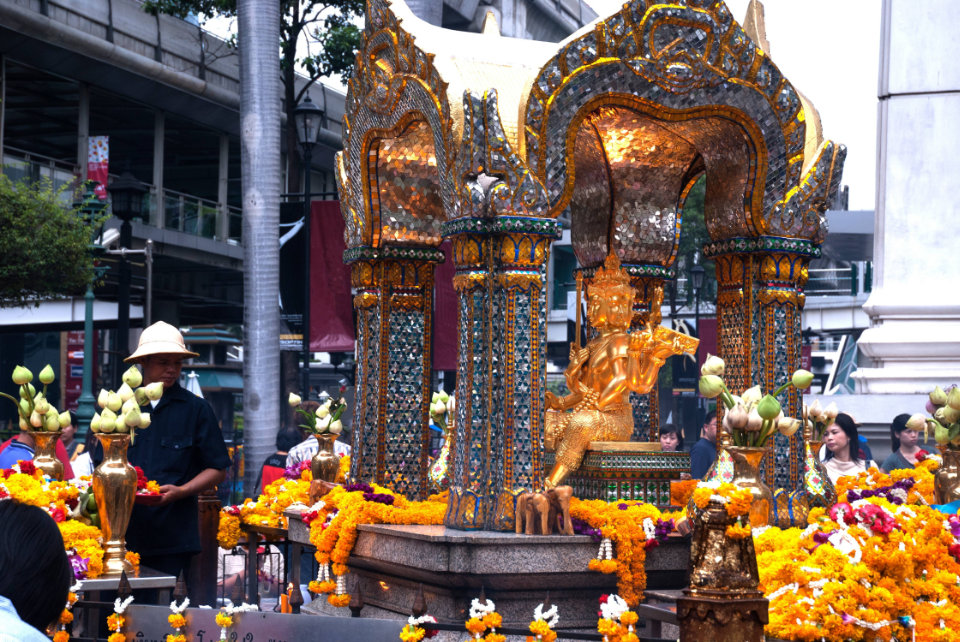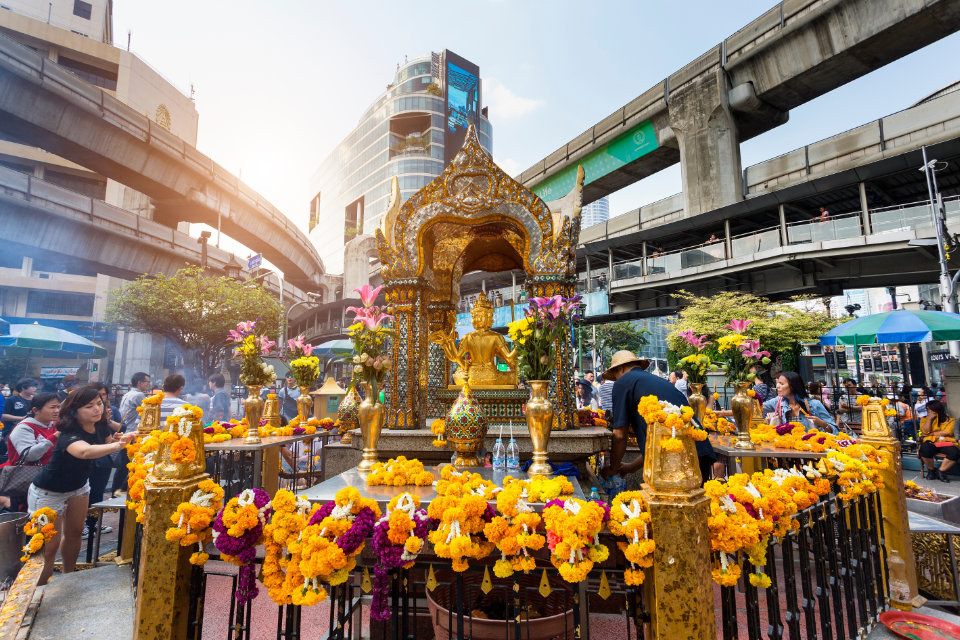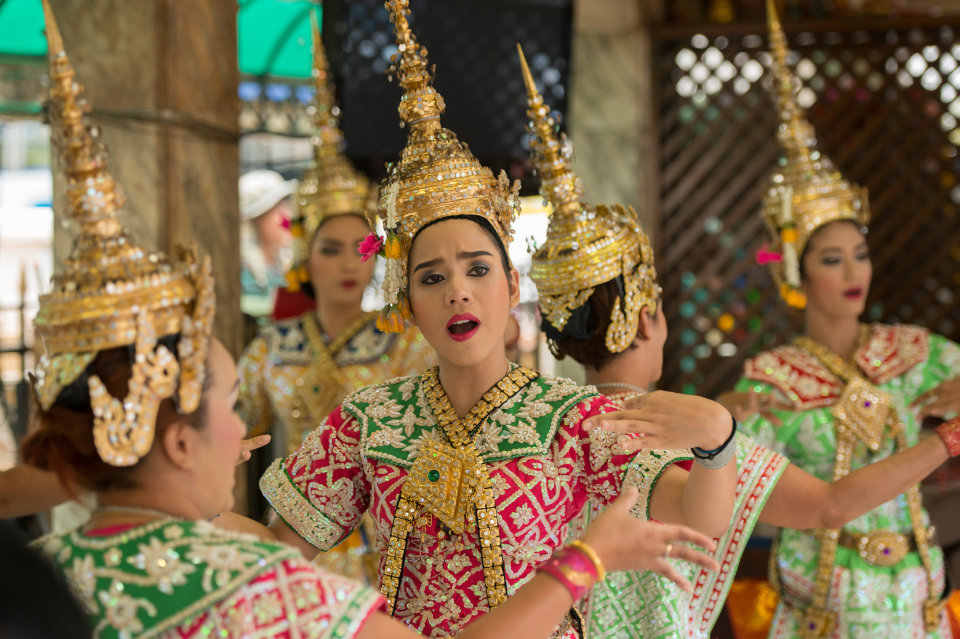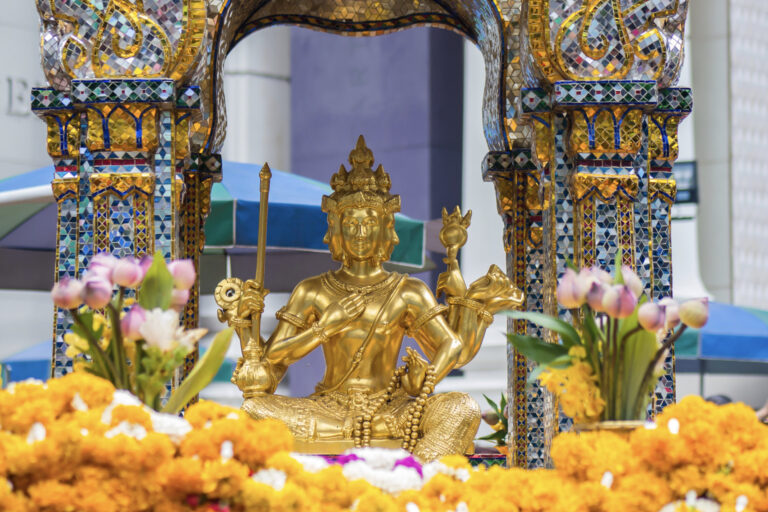Bangkok, the bustling capital of Thailand, has a blend of modernity and rich cultural heritage. Among the city’s countless temples and shrines, the Erawan Shrine, formally known as the Thao Maha Phrom Shrine (Thai: ศาลท้าวมหาพรหม; RTGS: San Thao Maha Phrom; ‘shrine of Lord Maha Brahma’), stands as a popular destination for locals and tourists alike.
The shrine houses a statue of Phra Phrom, the Thai representation of Brahma, the Hindu god of creation. The name might also refer to Mahabrahma, the ruler of the Brahma realm in Buddhist cosmology.
The Erawan Shrine is a symbol of hope, faith, and spirituality, home to the four-faced Brahma. Visitors to the shrine find themselves enveloped in a spiritual ambiance that transcends cultural boundaries. Here, people from all walks of life come to seek blessings, make vows, and pay homage to the deity, engaging in practices such as praying to god and ancestors.
Whether for fulfillment in love, success in business, or general well-being, the Erawan Shrine serves as a focal point for expressing one’s deepest desires and gratitude.
Now, delve into the mystical world of devotion and discover how you can invite the blessings of the four-faced Buddha at the Erawan Shrine. Continue reading to unlock the secrets of this timeless tradition.
Table of Contents
Information on the Four-Faced Buddha, Erawan Shrine in Bangkok, Thailand
- Address: Ratchadamri Rd, Khwaeng Lumphini, Khet Pathum Wan, Krung Thep Maha Nakhon 10330, Thailand
- Transportation: BTS Chit Lom Station
- Opening Hours: 07:00-23:00 (Monday to Sunday)
How to Get to the Erawan Shrine
The Erawan Shrine is strategically located in the Ratchaprasong business district, right below the Grand Hyatt Erawan Bangkok Hotel. Reaching the Shrine is simple:
- By BTS Skytrain: Take the BTS to Chit Lom Station (E1), Exit 2. Follow the BTS Skywalk, and you’ll find yourself at the Shrine in less than a 5-minute walk.
Symbolism and Significance of Four-Faced Buddha at Erawan Shrine
The Erawan Shrine was built in 1956, during the construction of the Erawan Hotel. The construction faced several obstacles and misfortunes, leading the workers to seek spiritual guidance.
A renowned spiritual leader suggested erecting a shrine to honor Brahma, the four-faced Hindu god of creation. The hotel’s name was later changed to Grand Hyatt Erawan, and the Shrine remains at this location to this day.
The Four-Faced Buddha in the Shrine is not Buddha but Brahma, and its correct name is Phra Phrom. This four-faced deity is highly revered in Thai culture, symbolizing protection and prosperity.
Historical Significance
Over the years, the Erawan Shrine became a spiritual focal point for both Thai people and international visitors. It survived the vicissitudes of time, including a devastating bombing in 2015, which shook the community but did not diminish the Shrine’s spiritual stature. The swift rebuilding of the statue was seen as a triumph of faith over adversity.
Symbolism of the Four Faces
The four faces of Phra Phrom at Erawan Shrine each oversee a different aspect of life. The faces collectively symbolize completeness and well-rounded success in various dimensions:
- Academics and Learning: The first face represents the quest for knowledge and wisdom. It’s often sought after by students and scholars.
- Career and Professional Growth: The second face signifies success in business and work life, guiding professionals in their career paths.
- Wealth and Prosperity: This face is associated with material success and financial stability, attracting those who seek economic well-being.
- Health, Family, and Luck: The last face focuses on overall well-being, family harmony, and good fortune in life.
Artistic and Architectural Marvel
The statue itself is a stunning piece of art, with each face intricately carved and gleaming with gold. It’s placed on a high platform, surrounded by offerings of fresh flowers, incense, and candles. Thai classical dance performances, organized by devotees as a fulfillment of vows, add to the enchanting ambiance.
Cultural Integration
The Four-Faced Buddha at Erawan Shrine illustrates the blending of Hindu and Buddhist beliefs in Thailand. While the Shrine is dedicated to a Hindu deity, it is embraced by Buddhists and people of other faiths.
The Shrine transcends religious boundaries, embodying a universal aspiration for success, peace, and fulfillment.
How to Worship the Four-Faced Buddha at the Erawan Shrine

Here’s a step-by-step guide to properly worshipping at the Erawan Shrine:
Total time: 30 minutes
Purchase Offerings
Offerings like candles, flowers, and incense can be purchased at the green pavilion within the Shrine area.
Wash Your Hands
Symbolizing purity, wash your hands at the holy water station before proceeding.
Worshiping the Faces
Begin with the face facing the entrance (the side where the leg touches the ground), and place a candle, a garland, and three incense sticks. Before praying, first recite the Four-Faced Buddha mantra: Om Po Romasa Habhadiṣa Rama (嗡 波 罗玛萨 哈巴 狄沙 拉玛), before proceeding.
Move clockwise, placing a garland and three incense sticks at each of the remaining faces. If you are seeking something specific from the Four-Faced Buddha, make a wish and leave a vow detailing how and when you will fulfill it.
Sprinkle Holy Water
After completing the worship, lightly sprinkle holy water on your head. If holy water is not available, you can alternatively use clean, purified water as a symbolic gesture of blessing and purification.
PS: If you wish to purchase a Four-Faced Buddha amulet, you can inquire with the staff working at the shrine. Usually, the amulet has been consecrated (开光) and obtained from the main Four-Faced Buddha Erawan Shrine.
Correct Way of Making a Wish to the Four-Faced Buddha at the Erawan Shrine
Sincerity makes wishes come true; keep your mind uncluttered.
Step One: Offerings
The Four-Faced Buddha favors flowers such as chrysanthemums, orchids, and roses. Therefore, in Thailand, people usually worship with chrysanthemums, orchids, or roses (symbolizing love), offering them in a clockwise sequence to each of the deity’s four faces.
It is recommended not to buy offerings for worship or fulfilling vows at the stalls outside the Four-Faced Buddha’s entrance, as they tend to be overpriced. Purchase them inside, where prices are clear and fair to tourists.
The cheapest offering is 20 baht, including three sticks of incense for each face (total 12 sticks), one candle, and a string of flowers. Other options are available for 50 baht, 100 baht, etc.
Step Two: Worshiping
- Start facing the front, worshiping clockwise with hands pressed together, holding the incense between the palms. You can either kneel or bow. For each face of the Buddha, offer one candle, three sticks of incense, and one flower garland. Worship clockwise around all four faces, then return to the first face and repeat your wish. Be clear about how and when you will fulfill your vow if it is granted.
- It’s best to repeat your wish or request to each face of the Buddha, so every face hears the same words. This is the proper way to worship.
- When making a vow, state to the Four-Faced Buddha how you will fulfill it. The rarer the method of fulfilling, the easier it is for the wish to come true. Requests for dancers, jasmine garlands, and carved wooden elephants are too common and may not be fulfilled quickly.
Step Three: Holy Water Purification
Finally, go to the left side for purification, using a tin bowl to scoop clean water to wash the basin. Splash the water on your forehead, face, and arms to seek the Four-Faced Buddha blessing and purify your soul.
Be very clear when making a vow!
For example:
My name is so-and-so. I am from (place) and stay at (address). Today, I am here to request (specific wish). Please fulfill my wish for (details of the wish) by (date). (Specify the amount if asking for wealth, the conditions if asking for love, or the achievements if asking for a job). If this comes true, I will fulfill my vow with (specific offerings, such as carved wooden elephants or hiring dancers to dance, etc.) by (date/deadline).

Although none of the prohibited items were lit, devotees were still praying with unlit candles and incense sticks. These items are still being sold; they’re just not being lit. So use your sincerity instead! The adaptation to these changes illustrates a beautiful fusion of respecting tradition while adapting to contemporary needs and concerns.
Fulfilling a Vow to the Four-Faced Buddha at the Erawan Shrine
Fulfilling the vow is very important.If you make a vow to the Four-Faced Buddha and your wish comes true, remember that you must fulfill your promise. Otherwise, whatever the Four-Faced Buddha has bestowed upon you can also be taken back.
What you use to fulfill the vow depends on the promise you made at the time. Some people use suckling pigs, some use boiled eggs, some use desserts, and some even dance on the spot or volunteer. It really depends on your commitment. If you still don’t know what to offer, you can try these simple ‘vow fulfillment packages’:
Vow Fulfillment Menu (just point to the staff and say ‘fulfill the vow,’ and they will understand):
- Four strings of seven-colored flowers – one string for each face
- Four candles – one for each face
- Twelve incense sticks – three for each face
- Four wooden elephants – one for each face
Dance to Fulfill the Vow – Next to the Four-Faced Buddha, there are some ‘Thai Live Bands’ and dancers with price tags indicating the cost. The vow fulfillment dances come in 2-person, 4-person, 6-person, and 8-person dancer variations.
Just tell the staff how many people, give your name, and they will write up the order for you. Then wait for your name to be called, kneel down, and the dancers will read your name and begin to dance to the song for a few minutes.
Make a Heartfelt Donation – There are donation boxes; the more, the better! The entire package costs about 2,000 baht, depending on the size of the wooden elephants you buy and how much money you donate.

Tips for a More Devoted Prayer to the Four-Faced Buddha
The Four-Faced Buddha at the Erawan Shrine in Bangkok is considered a powerful spiritual entity that requires certain traditional and respectful approaches for worship.
Here are some tips to guide your experience:
- 1. Pray after 7 pm on Thursday Night: Thursday night, especially after 7 pm, is considered a particularly auspicious time to pray to the Four-Faced Buddha. In Thai culture, Thursday is associated with the planet Jupiter, which symbolizes growth, expansion, and spirituality. Offering prayers during this time is believed to enhance the connection with the deity and increase the likelihood of blessings.
- 2. Take Off Your Footwear When Praying: Removing shoes before entering a sacred space or praying is a common practice in many Asian cultures, including Thai. It signifies the act of leaving the worldly dirt outside and entering the sacred space with purity. By taking off your shoes, you show respect to the holy place and acknowledge your humility before the divine.
- 3. Dress Respectfully: When visiting the Erawan Shrine or any sacred place in Thailand, modest and respectful clothing is expected. This often means covering shoulders and knees. Wearing appropriate attire signifies respect for the spiritual environment and creates a more conducive atmosphere for devotion.
- 4. Speak Your Prayer Clearly and with Sincerity: When praying to the Four-Faced Buddha, it’s essential to speak clearly and with sincere intent. Whether making a vow or seeking guidance, clarity in your words reflects purity in your intentions. Remember, it’s not the language but the sincerity that matters. You can also recite the Four-Faced Budhha mantra.
- 5. Offer Incense, Candles, Flowers, Coconuts, Elephant Idols, and More: Traditional offerings to the Four-Faced Buddha are diverse and symbolically rich. Along with incense, candles, and flowers, devotees often present coconuts, elephant idols, and other items that have specific significance:
- Incense and Candles: These symbolize light and purity, guiding the way for prayers to reach the divine. They also purify the environment, making it conducive to spiritual connection.
- Flowers: Flowers represent the impermanence of life, beauty, and respect. Different types of flowers might be used for different faces of the Buddha.
- Coconuts: Offering coconuts is believed to signify the breaking of the human ego, revealing the pure, sweet inner self. It can be seen as a gesture of complete surrender and devotion.
- Elephant Idols: The elephant is a sacred symbol in Thai culture, representing wisdom, power, and protection. Offering an elephant idol can be a way to seek the Four-Faced Buddha’s blessings in these areas.
- Gold Leaves: Applying gold leaves to the statue is a common practice, symbolizing dedication and the wish to gain merit in spiritual life.
Choosing the right offerings involves understanding their symbolism and relating them to your personal prayers and wishes. They are not merely gifts to the deity but thoughtful expressions of faith, devotion, and aspiration.
These offerings enhance the prayer experience by engaging the senses and conveying specific wishes and intentions. They help create a connection with the Four-Faced Buddha, grounding the spiritual experience in physical acts of devotion and respect.
Four-Faced Buddha Mantra
The popular mantra associated with Phra Phrom (Four-Faced Buddha) is:
“Om Maha Surinyai Namaha Om Brahma Brama Barami Soha”
This mantra is chanted to pay homage to the deity and to seek blessings, good fortune, success, and protection from harm. Below is the long version.
Embracing the Divine Connection
The spiritual journey of praying to the Four-Faced Buddha at Erawan Shrine is not just a unique experience in itself but a part of a rich tapestry of spiritual practices. It resonates with the traditions of praying to Guan Gong, seeking blessings from the God of Wealth, finding courage through praying to Tiger God, or embracing compassion by praying to Guan Yin.
Each path invites you to explore the deepest desires of your heart and challenges you to act with integrity and sincerity.
As you offer your prayers to the Four-Faced Buddha, you engage with a heritage that links the human and divine, the material and spiritual.
By understanding and respecting the steps, offerings, and taboos, you’re not merely following a cultural practice; you’re participating in a timeless bond of faith and commitment that transcends individual deities and reaches into the core of human spirituality.
Now, ask yourself: What is your heart’s true desire, and how will you honor the sacred trust between you and the divine when your prayers are answered?
What is the best time to pray to the Four-Faced Buddha at Erawan Shrine?
Although the shrine is open from 7:00 AM to 11:00 PM daily, many believers recommend praying after 7 PM on Thursday for an enhanced spiritual connection.
Can I buy offerings for the Four-Faced Buddha at Erawan Shrine?
Yes, offerings can be purchased inside the Erawan Shrine at fixed prices. Outside vendors may charge more, so it’s advised to buy from within the shrine.
What should I wear when visiting the Erawan Shrine?
Dress respectfully when visiting the shrine. Modest clothing that covers the shoulders and knees is recommended. Footwear should be removed before praying.
How do I fulfill a vow to the Four-Faced Buddha if my wish comes true?
Fulfilling a vow can involve various offerings, including dance performances, carved wooden elephants, or food offerings like roast pig or sweets. It depends on the specific vow made.
Is it necessary to pray to all four faces of the Buddha at the Erawan Shrine?
Yes, it’s essential to pray to all four faces equally and in a clockwise direction to show respect and avoid invoking jealousy from the deity.
What are the common offerings made to the Four-Faced Buddha?
Common offerings include incense, candles, flowers such as marigolds, orchids, or roses, and other items like coconuts or elephant idols. Special offerings can be made based on individual vows.
Does the Four-Faced Buddha Have the Same Prayers for All Faces?
No, each face of the Four-Faced Buddha, also known as Brahma or Phra Phrom, represents a different aspect of life and has specific prayers associated with it. These faces correspond to different blessings:
First Face (Front): Represents career and success. Prayers here focus on achieving professional goals, promotions, or overcoming career obstacles.
Second Face (Right): Symbolizes relationships and harmony. Prayers are for improving family bonds, friendships, and romantic relationships.
Third Face (Back): Associated with wealth and prosperity. People pray for financial stability, business success, and monetary blessings.
Fourth Face (Left): Represents health and protection. Prayers are for good health, safety, and protection from harm or misfortune.
Do the Prayer Procedures Work the Same for All Four-Faced Buddha Statues?
Yes, the general prayer procedures for the Four-Faced Buddha are similar across various statues, but slight variations may occur depending on local customs or the specific temple.




2 Comments
Since each face of the Buddha represents a different aspect, do we recite separately the wish accordingly?
Yes, you can make your specific wish at the relevant side of the 4-faced Buddha accordingly. If you have no wishes related to that specific side, you can simply pray normally.